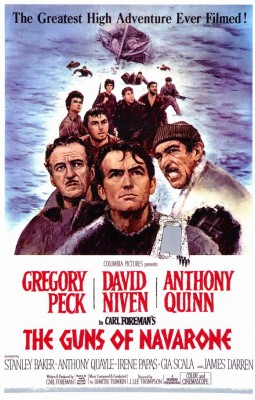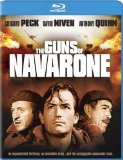| Reviews & Columns |
|
Reviews DVD TV on DVD Blu-ray 4K UHD International DVDs In Theaters Reviews by Studio Video Games Features Collector Series DVDs Easter Egg Database Interviews DVD Talk Radio Feature Articles Columns Anime Talk DVD Savant Horror DVDs The M.O.D. Squad Art House HD Talk Silent DVD
|
DVD Talk Forum |
|
|
| Resources |
|
DVD Price Search Customer Service #'s RCE Info Links |
|
Columns
|
|
|
Guns of Navarone, The
The same thing happened to The Guns of Navarone (1961), a seminal impossible mission/action spectacular adapted from Alistair MacLean's 1957 bestseller. On a budget of $6 million, the film turned an $18.5 million net profit, this at a time when a $1 million profit would have been regarded as a big success. The movie was printed and printed again and eventually the original film elements were damaged and two reels of the original negative were lost. For most of the past half-century, The Guns of Navarone, good as it is, has looked pretty lousy.
Sony's latest restoration of the film isn't picture perfect, but compared even to the May 2000 DVD the improvements are striking. Most of the time the film looks great and throughout the audio is spectacular. This new release offers a new interactive feature, "The Resistance Dossier of Navarone," but mostly ports the many older but extremely worthwhile extras from previous DVD releases.
The film opens with a prologue, narrated by James Robertson Justice, detailing the strategies of Nazi Germany to force neutral Turkey into joining the Axis powers via their domination of the Aegean and their planned assault on 2,000 British soldiers stranded on the uninhabited Greek island of Keros. Ultimately, though, it's all to set up the (wholly fictitious) story, in which Captain Keith Mallory (Gregory Peck), an experienced mountain climber who speaks both Greek and German fluently, is recruited to assist Major Roy Franklin (Anthony Quayle) on a suicide mission to take out two colossal, radar-directed guns on Navarone (also fictitious), tucked away in an impregnable mountainside overlooking the Aegean.
Mallory in turn recruits former Greek colonel Andrea Stavrou (Anthony Quinn), who in a subplot blames Mallory for the death of his family. Franklin enlists munitions expert Corporal Miller (David Niven), along with engineer Brown (Stanley Baker) and Greek-American Spyros Pappadimos (James Darren), the latter with family on the island.
The Guns of Navarone doesn't hold up all that well to multiple viewings precisely for reasons that makes it so wonderful when seen for the first time. The picture cleverly presents its characters with a basically impossible suicide mission, then as each obstacle is just barely surmounted their difficulties are compounded with new, unanticipated ones, each a potential game-ender. The picture does an expert job conveying the grueling efforts of the team, relating especially to Niven's humanist, the moral center of the film. Who hasn't watched them ascend the impossibly steep seaside cliff - at night, during a pounding rainstorm - without asking whether they'd be up to the task themselves? (Me? No way!)
In this sense the picture is similar to Akira Kurosawa's The Hidden Fortress, which was specifically written that way. Kurosawa asked his screenwriter collaborators to place their heroes in an impossible situation scene after scene, the challenge being to find them a way out of trouble each time. (Mild Spoilers) In The Guns of Navarone it's never-ending. Their boat is intercepted and boarded by suspicious Germans. Later it crashes against the rocks and sinks, leaving everyone stranded. Franklin is injured almost from the start, his leg broken in two places, making him an incapacitated and therefore dangerous liability.
And, like The Hidden Fortress, Navarone has no weighty message or flags to wave. It's 100% entertainment, with the propaganda found in war movies made during and immediately after the war replaced with biting cynicism. The film was incredibly influential. Movies like Tarantino's Inglourious Basterds can be traced directly back to The Guns of Navarone and its innovative take on the war movie genre.
Gregory Peck's character is fascinating, particularly once Franklin is injured and Mallory takes command. Only a big Hollywood star with his established persona could get away with playing such a ruthless, single-minded leader. (Brad Pitt's character in Basterds is similar but even more extreme in this regard.) General audiences probably don't notice how many times he kills or is willing to kill in cold-blood to protect the mission. When Stavrou suggests the injured Franklin be shot lest he fall into enemy hands and, in his weakened state, be induced into revealing the mission, Mallory appears to come to Franklin's rescue. He's gentle with exactly the kind of bedside manner one would expect from Gregory Peck.
Look closely though and you'll see he keeps Franklin alive solely because he's useful, and when it's in his best interests to leave him for the Germans to find he does just that. Had Franklin put the mission at risk, there's no doubt Mallory wouldn't have hesitated in killing him.
The film obviously sprang from the huge success Columbia had with The Bridge on the River Kwai (1957), the popular Best Picture-winner, a war movie also featuring American and British stars, and also written by Carl Foreman, who wrote and produced this. Though Foreman and Michael Wilson were blacklisted and their names removed from Kwai's credits, Columbia was certainly aware of who'd actually written the thing, and for obvious reasons wanted to duplicate its unprecedented success.
The Guns of Navarone makes excellent use of its great cast. It helped revitalize Niven's career as a leading man, one that, Around the World in 80 Days (1956) notwithstanding, had dimmed over the previous decade, with the actor mostly appearing in lower-budgeted movies and on TV. He's especially good in all his scenes with Peck, particularly one where Peck's character chews him out. Though fourth-billed, Stanley Baker got a boost from the film's high profile success and became a full-fledged star from that point on. Also on the rise, Richard Harris has an amusing if small role as an Australian squadron leader.
Filmed on location with some studio exteriors matching quite well most of the time, Navarone is lavish and expensive-looking, touting excellent (for the time) special effects, including numerous matte shots and miniatures, some seamlessly integrated.
Video & Audio
Sony's latest restoration of The Guns of Navarone presents the film's 2.35:1 CinemasScope, original (on British prints) Technicolor image in the best possible light. The results are uneven. At times the region-free picture is dazzlingly sharp with rich color, while at other times hues are noticeably browner and the image grainer. Several whole reels are like this, as are most dissolves and other opticals. But even at its weakest The Guns of Navarone still looks quite good, and the color timing is notably spot-on, with the many nighttime exteriors reading exactly right, and the special effects shots timed to minimize the trickery.
I also like how viewers are given the option to watch the film with or without its original roadshow intermission card. Audio-wise, Navarone's 5.1 DTS-HD Master Audio mix really comes alive during the battle scenes, the explosive climax, and whenever Dimitri Tiomkin's famous score is heard, which is most of the time. French and Portuguese audio tracks are included, as well as subtitle options in English, French, Spanish, Portuguese, Thai, Arabic, Chinese, Dutch, and Korean.
Extra Features
The big new supplement is the aforementioned interactive feature, which is okay for what it is and in high-def but not all that interactive or interesting, especially when compared to older, richer extras ported over from earlier releases, and which included the participation of Peck, Quinn, and director J. Lee Thompson, all of whom have since passed away. The three documentaries and eight featurettes are further supported by two audio commentaries, an excellent one by film historian Stephen J. Rubin, the other by director Thompson. Most of this material is 480p, but a few things, such as the "Message from Carl Foreman," a short prologue intended for the movie's premiere in Australia, have been bumped to high-def.
Parting Thoughts
I envy those who'll get to see The Guns of Navarone for the first time on Blu-ray, unlike the rest of us (well, my generation anyway) who first saw it panned-and-scanned on network television, interrupted every ten minutes by five minutes of commercials. The presentation is outstanding considering the state of the original film elements while the extras, even the old ones, are great. Highly Recommended.
Stuart Galbraith IV's latest audio commentary, for AnimEigo's Musashi Miyamoto DVD boxed set, is on sale now.
|
| Popular Reviews |
| Sponsored Links |
|
|
| Sponsored Links |
|
|
| Release List | Reviews | Shop | Newsletter | Forum | DVD Giveaways | Blu-Ray | Advertise |
|
Copyright 2024 DVDTalk.com All Rights Reserved. Legal Info, Privacy Policy, Terms of Use,
Manage Preferences,
Your Privacy Choices | |||||||














